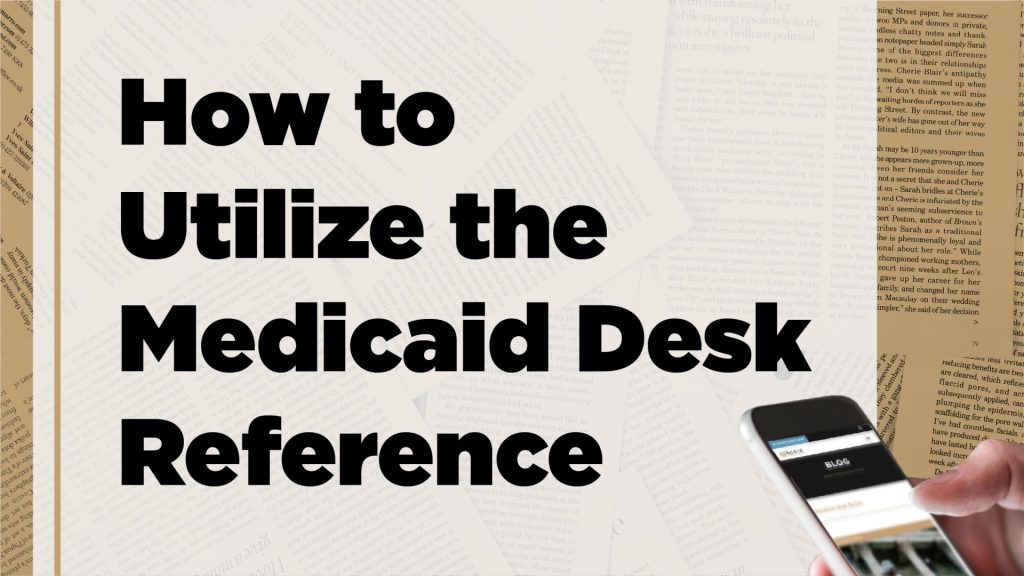How to Use the Medicaid Desk Reference

Disclaimer: Since Medicaid rules and insurance regulations are updated regularly, past blog posts may not present the most accurate or relevant data. Please contact our office for up-to-date information, strategies, and guidance.
It is always helpful to have a “cheat sheet” on hand to quickly reference your state’s Medicaid planning figures when advising a new client or preparing a new case. However, while some figures you may use quite frequently, others may be referenced less often. As such, it is important to understand the meaning behind each of these limits and when they may be applicable to your client.
What is the Medicaid Desk Reference?
The Medicaid Desk Reference is intended to provide a state-specific roadmap for developing your client’s personalized spend-down plan. A quick review of this essential tool will help you answer common questions such as:
- How many assets can my client keep?
- What is the length of time my client will be considered ineligible due to a previous gift?
- Is the community spouse eligible for an income shift?
Most states update their figures at least twice per calendar year in January, July, or October, though some states may issue updates to their state figures outside of these common times and without any prior notice.
It’s imperative you stay up to date on any changes to your state-specific Medicaid planning figures.
Click here to sign-up for your free Attorney Access account now!
Listed below are a few of the key terms you will find noted on the Medicaid Desk Reference as well as descriptions you can refer to when utilizing this reference tool in order to better structure your client’s Medicaid crisis planning cases.
Divestment Penalty Divisor
The Divestment Penalty Divisor is a state-specific figure that is constructed based on the average monthly private-pay rate for nursing home facilities in that state. In order to determine the penalty period (the phase of ineligibility an applicant is subject to when they have divested assets within the five-year lookback period), the total divestment amount is simply divided by the Divestment Penalty Divisor. The resulting figure provides the number of months that your client will need to privately pay for their care through during that penalty period. The divisor varies greatly by state as some states may use a daily rate to determine the divestment penalty divisor or even utilize multiple divisors.
Individual Resource Allowance
When determining the amount of assets that the institutionalized individual may retain, you will want to reference the Individual Resource Allowance. This figure dictates the amount of countable assets that a Medicaid applicant can retain while still qualifying for Medicaid benefits. This allowance, typically $2,000 in most states, provides a small amount to the institutionalized individual that they can draw on for personal discretionary spending.
Resource Allowance for a Couple
In the event that both spouses reside in a nursing home at the same time, they will not each be entitled to retain their own Individual Resource Allowance. Instead, they will be entitled to a separate resource allowance amount to be shared between the two of them.
Personal Needs Allowance
The Personal Needs Allowance is the amount of income that a Medicaid recipient is entitled to each month that can be used for their personal expenses such as toiletries, clothing, or haircuts. This amount is reduced from the applicant’s net income each month and is not required to be used towards their monthly co-pay at the facility. Any amount of the personal needs allowance that is not spent within that month, will be assessed to the applicant’s assets. This figure varies by state and can range from $30-$200, depending on the state.
Community Spouse Resource Allowance (CSRA)
In a crisis planning scenario where one spouse is institutionalized and the other spouse remains at home in the community, each individual is entitled to retain their own resource allowance. As the name indicates, the Community Spouse Resource Allowance (CSRA) dictates the amount of countable assets that the community spouse is entitled to retain when qualifying the institutionalized spouse for Medicaid benefits. Any excess assets that exist beyond this resource allowance must be spent down before Medicaid eligibility for the institutionalized spouse can be achieved. This figure can vary by state as some states have imposed a standard figure while others have implemented a minimum/maximum range.
Standard CSRA States:
In states where a standard CSRA figure is implemented, the couple must spend-down any excess countable assets that exceed this limit in order to qualify the institutionalized spouse for Medicaid benefits.
Minimum/Maximum CSRA States:
Other states that do not implement a standard figure, may impose a minimum/maximum asset range that the couple must adhere to. In these states, the community spouse is entitled to retain one-half of the couple’s assets as of the “snapshot date,” or the first date after which the Medicaid applicant spent 30 consecutive dates in a facility receiving institutionalized level care. The amount that the community spouse can retain may not exceed the maximum nor fall below the minimum.
Learn More: How Does Medicaid Determine the Snapshot Date?
Monthly Maintenance Needs Allowance (MMNA)
This figure determines the amount of income that the community spouse may be entitled to receive from the institutionalized spouse each month through a shift of income. To determine whether the community spouse is entitled to this shift of income, you will need to establish whether the community spouse’s income is less than the MMNA. If so, they may be entitled to receive a portion or all of the institutionalized spouse’s income, in order to increase the community spouse’s income to at least the minimum MMNA. Similar to the community spouse resource allowance, some states may impose a standard figure, while others may enforce a minimum/maximum range.
Standard MMNA States:
In these states, if the community spouse’s income is more than the MMNA, they will continue receiving their own income as usual. However, if their income is less than the standard MMNA figure, they will be entitled to an income shift of the difference from the institutionalized spouse’s income. This amount may vary by state, but is generally capped at $3,435 for 2022.
Minimum/Maximum MMNA States:
In states where a minimum/maximum range is imposed, the community spouse may be entitled to an income shift from the institutionalized spouse that exceeds the minimum MMNA, depending on their total shelter expenses. The community spouse will always be entitled to the minimum, but they may be eligible to receive more if they have shelter expenses that are above a certain threshold, not to exceed the maximum MMNA.
Shelter Standard
The Shelter Standard represents the amount of shelter expenses that the community spouse is responsible for each month. This is a base figure intended to encompass all of the community spouse’s monthly shelter expenses (mortgage payments, real estate taxes, etc.) and can be utilized to increase the community spouse’s entitled MMNA. If the community spouse’s total expenses exceed the Shelter Standard, their MMNA is increased dollar-for-dollar from the minimum MMNA in order to account for the difference, not to exceed the maximum. This figure may vary by state but is typically $653.25 for 2022 in most states.
Standard Utility Allowance
Since monthly utility costs can fluctuate from month-to-month, the Standard Utility Allowance is a standardized figure that is used by the state Medicaid agency in place of a community spouse’s actual utility costs. This figure can vary by state and is used to help calculate a community spouse’s total shelter expenses.
Funeral Expense Trust Limit
In order to be considered exempt for Medicaid purposes, the face value of an Irrevocable Funeral Expense Trust must typically be below $15,000, in most states. However, this figure can vary greatly by state as some states have no such limitation. Many states also require that a Letter of Goods and Services accompany the funeral expense trust in order to show proof of value.
To determine if your state requires a Letter of Goods and Services, contact our office at 866-605-7437 and ask to speak with one of our skilled Benefits Planners today.
Life Insurance Limit
If the face value of the life insurance policy is less than the state-specific limitation, the cash value of the policy is considered an exempt resource for Medicaid purposes. In most states, this limitation is $1,500.00, although this value may vary by state.
Home Equity Limit
The Home Equity Limit is a standardized limit that applies to the amount of equity that an unmarried individual who is seeking Medicaid benefits can retain in their home. Any equity amount that exceeds this limitation will result in the excess equity of the home being considered a countable resource for Medicaid eligiblity purposes, unless the excess equity amount can be reduced below the home equity limit. The home equity is the difference between the appraised or fair market value of the property and any debts, liens or encumbrances on the property. In most states the home equity limit is $636,000.00 for 2022.
Learn More: How Does a Reverse Mortgage Affect Medicaid?
For more information about how you can use your Medicaid Desk Reference, click here to view our free webinar.



